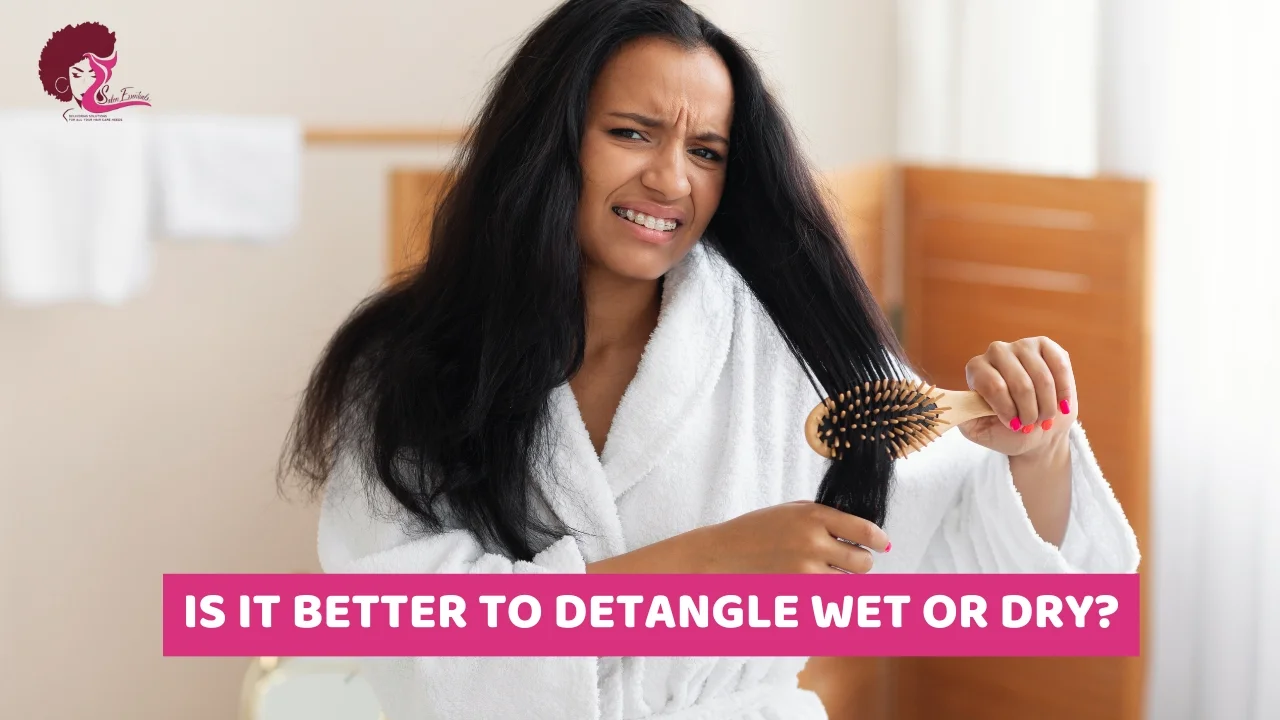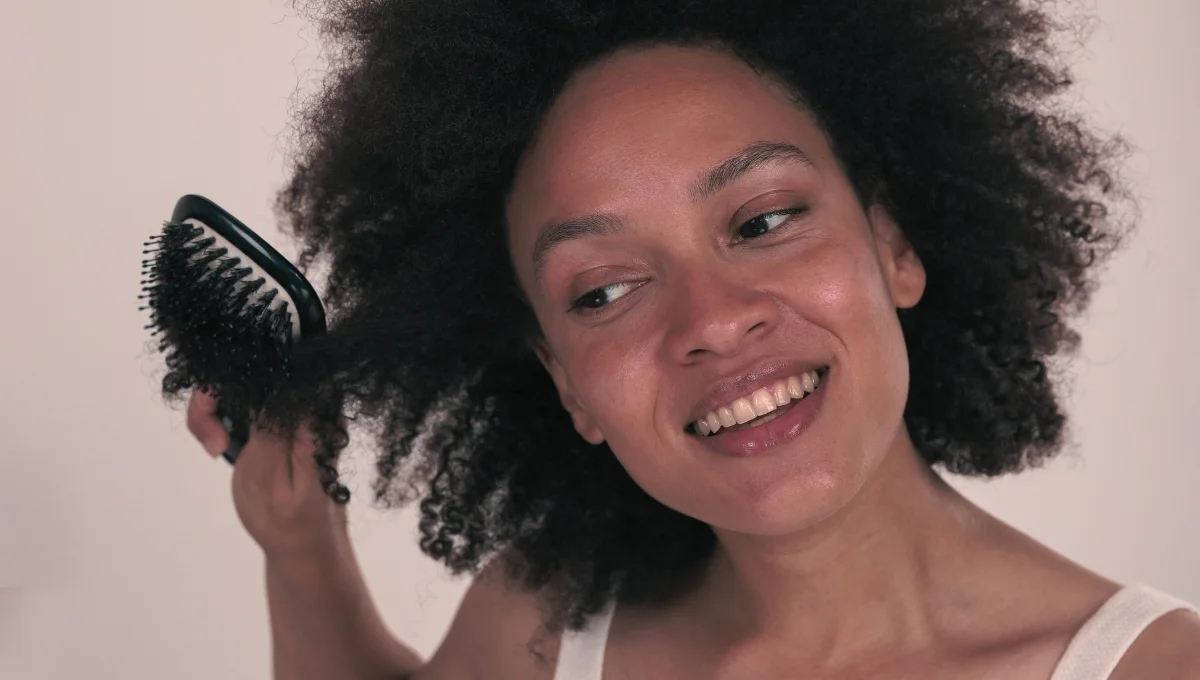
Ever reached for your brush only to be met with a tangled mess? Detangling is an essential part of any hair care routine, but the question remains: is it better to detangle wet or dry?
Both methods have their own advantages and disadvantages, and the best approach can vary depending on your hair type and the severity of the tangles.
In this blog, we will explore the benefits of each method, how to minimize damage, and offer expert tips for achieving smooth, tangle-free hair.
Understanding the Basics: Detangling Wet vs. Dry Hair
Detangling hair is a fundamental part of any hair care routine, but the method you choose—wet or dry—can make a significant difference in the health and appearance of your locks. So, What’s the difference between detangling wet and dry hair?
The key difference between detangling wet and dry hair lies in the state of your hair strands.
Wet hair
When saturated with water, hair becomes more elastic and pliable. This increased flexibility allows knots to loosen more easily, reducing the risk of breakage during detangling. Additionally, conditioner applied to wet hair acts as a lubricant, further minimizing friction and promoting smoother separation of tangled strands. For wet hair detangling tips, click here.
Dry Hair
Hair in its natural state is stronger and less prone to snapping. This makes it ideal for situations where you need to identify and remove individual tangles with more precision. However, dry hair can also be more prone to friction, potentially leading to breakage if not detangled with care.
Advantages of detangling wet hair over dry
Detangling wet hair offers several advantages, particularly for those with tangled or delicate strands–
Increased Elasticity
When hair is wet, it becomes more elastic and flexible due to water penetrating the hair shaft. This increased elasticity makes it easier to manipulate and detangle without causing excessive breakage. As a result, knots and tangles are more likely to loosen and unravel with minimal resistance.

Reduced Breakage
Wet hair stretches and becomes more pliable, allowing you to work through tangles with less risk of snapping strands gently. This is especially beneficial for hair that’s prone to breakage, fine, or curly.
Enhanced Manageability
Water acts as a natural detangle, softening hair and making it easier to comb or brush through. Conditioner further adds slip and reduces friction, allowing for a smoother and more manageable detangling experience.
Effective Detangling of Severe Matting
Looking for how to detangle severely matted hair? When dealing with severely matted hair, the softening and lubricating properties of water can be a lifesaver.
It’s common in curly or coily textures and can be extremely difficult to detangle dry. Wetting the hair and applying a generous amount of conditioner helps loosen the knots and allows for a more manageable detangling process.
Frizz Control
Wet detangling can help control frizz and flyaways, particularly for those with curly or wavy hair. By smoothing the hair cuticle and defining curl patterns while the hair is wet, you can achieve a more polished and cohesive look once the hair dries.
Improved Product Absorption
Applying conditioners, leave-in treatments, or detangling sprays to wet hair can enhance product absorption and effectiveness. Wet hair is more porous, allowing products to penetrate deeply into the hair shaft and provide nourishment and hydration from within. For better product absorption with wet detangling, click here.
The benefits of dry detangling

While wet detangling offers numerous advantages for some hair types, dry detangling shouldn’t be overlooked. Here’s why dry detangling can be the better choice for you–
Strong hair
Dry hair is naturally stronger than wet hair, making it less prone to breakage during detangling. This can be particularly beneficial for those with fine or heat-damaged hair that’s already fragile.
Easier tangle identification
Without the water-induced clumping, individual tangles are often easier to see and address in dry hair. This allows for a more targeted detangling approach, minimizing unnecessary manipulation.
Reduced frizz
For some hair types, particularly those prone to frizz, detangling wet can lead to increased fizziness as the hair dries. Dry detangling can help minimize this issue.
Expert advice on the best method for detangling wet or dry hair
So, wet or dry? The truth is, there’s no single “best” method for everyone. The ideal approach depends on your specific hair type and the severity of the tangles. Here’s what the experts recommend–
“For most hair types, especially those prone to tangles, detangling wet in the shower with conditioner is ideal. The added moisture and lubrication make the process smoother and minimize breakage.” – Hairstylist Sarah Jones.
“If your hair is very dry, damaged, or prone to breakage, detangling dry might be a safer option. However, using a detangling spray or leave-in conditioner beforehand is crucial to add slip and prevent pulling.” – Trichologist Dr. Ana Garcia.
“The best way to detangle hair is to brush or comb it in small sections, starting at the ends and working your way up. This method gently removes tangles instead of aggressively trying to break through them.” – Garnier.
Common mistakes when detangling wet hair
While detangling wet hair offers numerous benefits, there are some pitfalls to avoid–
Brushing from Root to Tip
This puts unnecessary stress on tangled hair, leading to breakage. Always start at the ends and work your way up in sections.
Using harsh brushes or combs
Regular brushes with tight bristles can snag and pull on wet hair, causing breakage. Opt for a wide-tooth comb or a detangling brush designed for wet hair.
Skipping conditioner
Conditioner is essential for detangling wet hair. It acts as a lubricant, reducing friction and making it easier to comb through tangles.
Rough towel drying
Rubbing your hair with a towel after showering can disrupt the hair cuticle and worsen tangles. Gently squeeze excess water or pat your hair dry with a microfiber towel.
Detangling extremely tangled hair without prepping
Hair is most vulnerable right after getting wet. Wait a few minutes for the conditioner to absorb and the hair cuticle to close slightly before detangling.
How to minimize hair damage while detangling wet or dry
Whether you choose the wet or dry approach, detangling can be done with minimal damage by following these key principles–
Always be gentle
Patience is key! Avoid forceful pulling or yanking at tangles, as this is the main culprit behind breakage. Work slowly and gently to loosen knots.
Start at the ends and work your way up
This prevents pulling on the entire hair strand at once and minimizes the force needed to detangle.
Section your hair
Divide your hair into manageable sections to prevent a tangled mess and allow for more focused detangling.
Use the right tools
Ditch the harsh brushes! Opt for a wide-tooth comb or a detangling brush specifically designed for wet or dry hair, depending on your chosen method. These tools glide through tangles more easily, reducing friction.
Use conditioner
For wet detangling, a generous amount of conditioner acts as a detangling lubricant. For dry detangling, consider using a detangling spray or leave-in conditioner to add slip and reduce friction.
Conclusion
So, is it better to detangle wet or dry? There’s no one-size-fits-all answer! The ideal method depends on your hair type and the level of tangles. Experiment with both methods and see what works best for you.
And for all your hair care needs and expert-loved detangling products that minimize breakage and promote healthy hair, don’t forget to explore the Salon Essentials’ range! Visit us today!
FAQ
What is the best way to detangle matted hair?
Be gentle! Work with conditioner on wet hair, starting from the ends and using a wide-tooth comb. Patience is key to minimizing breakage.
Is water good for detangling hair?
Yes, water helps soften hair and makes detangling easier. Use lukewarm water and avoid hot water, which can damage hair.
Should I wash matted hair before detangling?
No, detangle first with conditioner on wet hair. Washing can tighten mats, making detangling harder.
Can I use conditioner as a detangler?
Yes! Conditioner acts as a lubricant to reduce friction and breakage during detangling.

